To be against sex in the nineteenth century was not only to challenge gender norms and sexual conventions but to propose a radical reorganization of society as nineteenth-century Americans knew it. Heterosexual sex was a linchpin of marriage, and by extension a linchpin of the family. Those who questioned the centrality of sex to human existence directly attacked the fundamental social conventions of their time. For Shaker and Catholic celibates, distance from one’s biological family could mean the creation of what gay humorist Armistead Maupin once termed “the logical family”—a community of people with shared values, or a family of choice. Families of choice have long been considered a cornerstone of queer culture. Prior to the legalization of same-sex marriage, these intentional families, networks of friends, lovers, and ex-lovers, were celebrated by queer scholars and activists.
The families of choice found within Shaker villages and Catholic religious communities provide important historical antecedents for understanding families of choice. Scholars within the fields of public policy and sociology have also recently pushed to decenter the nuclear family as the primary unit of study, recognizing that a great portion of our modern lives is spent outside family units, with friends, colleagues, and neighbors. Breaking away from families of origin and remaking them into families of choice were not incidental for Shaker and Catholic men and women, but should be understood as a deeply political act. The alternative structures of Shaker and monastic family life and the intimacies they created without sex built an explicit, nonnormative sexual culture in a society that rigidly presented heterosexual love and family as the only legitimate and legal option. The out-and-proud sexual abstinence of these groups also challenged dichotomies of public and private. Making their celibacy and sexual restraint an explicit aspect of group membership, rather than a privately held belief, allowed these subjects to create alternate institutions and family structures.
Groups that challenged sex and its role within the family sought more equitable gender relations and attacked men’s presumed ownership of women’s bodies. It is also important to note that within these remade and reformed families, abstinence from sex did not mean abstinence from love or affection.
